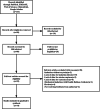Oxytocin use in trial of labor after cesarean and its relationship with risk of uterine rupture in women with one previous cesarean section: a meta-analysis of observational studies
- PMID: 33407241
- PMCID: PMC7786988
- DOI: 10.1186/s12884-020-03440-7
Oxytocin use in trial of labor after cesarean and its relationship with risk of uterine rupture in women with one previous cesarean section: a meta-analysis of observational studies
Abstract
Background: Trial of labor after a previous cesarean delivery (TOLAC) has reduced the rate of cesarean sections (CS). Nevertheless, the widespread use of TOLAC has been limited by an increase in adverse outcomes, the most serious one being the risk of symptomatic uterine rupture, which is possibly associated with oxytocin. In this meta-analysis, we explored the risk association between oxytocin use and uterine rupture in TOLAC.
Methods: Multiple electronic databases (PubMed, Embase, Web of Science, and Google Scholar) were searched for cross-sectional studies reporting on TOLAC, oxytocin and uterine rupture, which were published between January 1986 and October 2019. The bias-corrected Hedge's g was calculated as the effect size using the random-effects model. A two-sample Z test was used to compare the differences in synthetic rates between groups. The Newcastle-Ottawa Scale (NOS) was used to evaluate the risk of bias. Quality of the evidence was assessed with the Grading of Recommendations Assessment, Development, and Evaluation (GRADE) certainty ratings system.
Results: A total of 14 studies, which included 48,457 women who underwent TOLAC, met the inclusion criteria. The pooled rate of vaginal birth after a cesarean section (VBAC) and the rate of uterine rupture in spontaneous labor were 74.3 and 0.7%, respectively. In addition, the pooled rate of VBAC and the rate of uterine rupture in the induction labor group was 60.7 and 2.2%, respectively. The women who had spontaneous labor had a significantly higher rate of VBAC (p = 0.001) and a lower rate of uterine rupture (p = 0.0003) compared to induced labor. The pooled rates of uterine rupture in women using oxytocin and women not using oxytocin in TOLAC were 1.4% and 0.5%, respectively, and the difference was significant (p = 0.0002). Also, the synthetic rate of uterine rupture in oxytocin augmentation among women with spontaneous labor and women who had a successful induction of labor were 1.7% and 2.2%, respectively, without significant difference (p = 0.443).
Conclusions: Women with induced labor had a higher risk of uterine rupture compared to women with spontaneous labor following TOLAC. Oxytocin use may increase this risk, which could be influenced by the process of induction or individual cervix condition. Consequently, simplified and standardized intrapartum management, precise protocol, and cautious monitoring of oxytocin use in TOLAC are necessary.
Keywords: Oxytocin; Safety; Trial of labor after a previous cesarean delivery; Uterine rupture.
Conflict of interest statement
None.
Figures



References
-
- American College of Obstetricians and Gynecologists ACOG Practice bulletin no. 115: Vaginal birth after previous cesarean delivery [J] Obstet Gynecol. 2010;116(2 Pt 1):450. - PubMed
Publication types
MeSH terms
Substances
Grants and funding
LinkOut - more resources
Full Text Sources
Other Literature Sources
Medical
Miscellaneous

